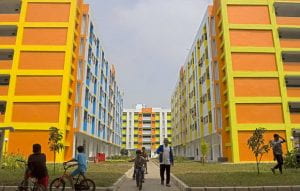Indonesia’s education has been lauded for its significant progress. The collective efforts of decentralized and central governments on education led to over 10 million children’s school enrollments since 2002 with roughly equal gender parity in education. The statistics of 2022 showcased such progress that almost all Indonesian children are enrolled in primary education (97.78%) and a considerable number are enrolled at lower secondary level (80.82%).
The glowing feats however conceal the enduring social issue of Indonesia: education inequality of economically underprivileged children living in urban slums (aka. informal settlements). The recent report by the University of Indonesia’s Center on Child Protection and Wellbeing reveals that the school completion rate among urban slum children is lower than the average school completion rate of Indonesian students. The gap between slum and non-slum children is especially more pronounced in the upper secondary level at 10.8%.
The enduring gap therefore shows that effort-making for ensuring equal and equitable education for urban slum children remains imperative in Indonesia, and the issue is even more critical at present than before due to growing urbanization. With the rapid pace of urbanization, Indonesia has been experiencing the expansion of urban poverty and the rise of the urban slum population who live alongside train tracks, riverbanks, and canals. About 38.2% of urban slum households have children, and such a large number of urban slum children suggests that the education experiences of those children must be re-examined to ensure their quality and equal education opportunities.
Figure 1. Slum communities under the overpass in Jakarta
Government’s Policy Approaches and Limitations
It is important to note that the Indonesian government’s attention, shown by politicians’ speeches and funding schemes, has heavily focused on sending children to school. However, needless to say, school-going is not equivalent to learning, and it does not guarantee the happiness of school-going children.
A. Indonesia Smart Card Program. To improve low-income children’s access to school, the Indonesian government has granted considerable financial aid, but slum children’s academic motivation and continuity of schooling were neglected in the process. The financial aid is called Indonesia Smart Card (KIP), which is one of the flagship programs launched under President Jokowi in 2014. The government has issued and distributed the cards to children aged 6-21 in low-income households, supporting them to use the money loaded to use it for school supplies (e.g., books, school uniforms), transportation costs, and more. The fundamental aim of the program has been to encourage low-income school-aged children to go to school and/or continue schooling until the completion of their high school education.
In the country’s capital city, Jakarta, alone, approximately 675,000 children were the recipients of the Jakarta-run Smart Card program this year. While the figure alludes to a considerable number of students benefitting from the program, the substantial impact is not clear due to problems, including numerous misuse cases (e.g., spending at shopping malls, gas stations, and karaoke) and out-of-school children’s use of money for non-education purposes. Referring to these loopholes of the financial program, Jakarta’s former governor Basuki Tjahaja Purnama criticized the program as waste.

Figure 2. Indonesia Smart Card (Mujab, 2020)
B. Rusunawa: Public Rental Housing Policy. Another policy that the Indonesian government implemented was for urban slum households’ better living conditions and sustainable cities, which however further interrupted children’s schooling. Aligned with the global commitment to Sustainable Development Goal 11 (i.e., Sustainable cities and communities), the government implemented a slum upgrading and prevention policy, called Kota Tanpa Kumuh (“City without Slum”) in 2007, which aimed at slum eradication by demolishing slum houses and instead building public low-cost flats (rusunawa) for urban slum dwellers.
However, the policy negatively affected slum children in regard to their mental health and schooling since it neglected children’s education in consideration. Slum households, including children, were forcefully evicted (often by military force) in the process of building rusunawa, which posed significant stress to slum children. When it comes to education, living in rusunawa deterred children’s learning since households had to bear monthly rent fees (IDR 250,000, or USD 16.75), which was an additional economic burden for them to support their children’s education costs. In addition, because of their forced relocation, children had to experience sudden parting from their friends and neighbors. Children also had to commute longer distances and hours from their new place to schools. In Jakarta, at the end of 2014, this public housing policy with little advantage to children’s education was discontinued due to a lack of fiscal support from its city council.

Figure 3. Rusunawa in Jakarta (Jakarta Review, 2018)
Notably, each policy case shows that the government’s focus has exclusively been associated with children’s access to school education and lack of consideration for children’s education, respectively. Moreover, neither policy paid attention to children’s socio-emotional well-being. This raises a critical need to examine the actual learning experiences of slum children at school.
Looking Closer the Slum Children’s Schooling Experiences
With its insufficient attention to the socio-emotional aspect, the current policy approach has perpetuated a non-inclusive and non-welcoming school climate towards slum children. It is a concerning situation that many slum children commonly experience discrimination, bullying, and exclusion in schools. Slum children are often the target of teasing, bullying, physical abuse, and rumors by their non-slum peers due to their poor living conditions, all of which demotivate slum children and even drive them to drop out of school. Their feeling of distress in school is often aggravated by teachers’ nonchalant attitudes towards slum children’s experience of bullying.
It can be interpreted that such a negative classroom climate tied with slum children’s lack of relationships with peers and teachers nullifies the aforementioned government’s efforts for slum children, which has entailed their academic demotivation, unhappiness, and school dropout.
Shifting the Policy Discourse to Child Rights-Based for Slum Children’s Well-being at School
If so, what should we focus on to actually promote slum children’s equal and equitable education? Greater attention must be given to ensure a positive school climate that is supportive and safe for children’s learning. Indeed, such an environment is the foundation as well as an enabler that could lead slum children to continue their schooling with increased academic motivation, a sense of belonging, and a feeling of being valued.
This means that the current policy approach should look beyond providing material/physical support, to promote slum children’s well-being and happiness in their school experience. In order to do so, the policy discourse should be shifted to be child rights-based.
It is the deficit view that has been permeated with the current policies, in which slum children’s education is considered as deprivations, problems, and obstacles that need to be addressed and fixed through access to schools and secure housing. The deficit view has justified and emerged the government’s financial aid and construction of a public rental house.
However, for slum children’s well-being and happiness in their long-term process of school education, the policy discourse should recall and include the core ideas of the Convention on the Rights of the Child (CRC) of 1989, particularly Article 29 (a):
“States Parties agree that the education of the child shall be directed to the development of the child’s personality, talents and mental and physical abilities to their fullest potential.”
The statement therefore calls for the Indonesian government’s child rights-based approach, reminding of its responsibility to focus on promoting education support that aligns with the best interests of the child. Based on this approach, the Indonesian government should prioritize providing holistic and whole-school support to foster a supportive school environment, ensuring slum children’s equal education opportunities, and enhancing their academic and socio-emotional skills to their fullest potential.
Then, what are some practical ways that the government could implement for child rights-based approach? Some practical strategies include organizing in-class anti-bullying workshops targeting both teachers and students, establishing community-based activities for a child-friendly school environment with mutual care, and implementing mentorship programs between university students and slum children to boost the latter’s academic motivation.
Taking all these into account, what should be kept in mind is: It is the Indonesian government’s utmost duty to prioritize the long-term effects and growth of slum children in pursuit of the child rights-based approach, which ultimately could lead them to become active members of Indonesian society with their full potentials.
By InJung Cho, Sigur Center Summer 2023 Field Research Grant Fellow. Cho is a Ph.D. student in Education at George Washington University. Cho researches educational inequality and learner identity of children in urban slums of Jakarta, Indonesia.
